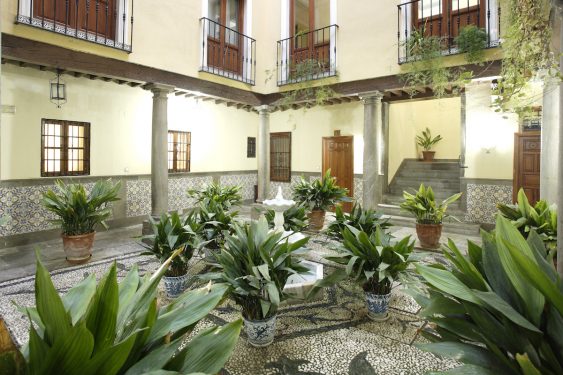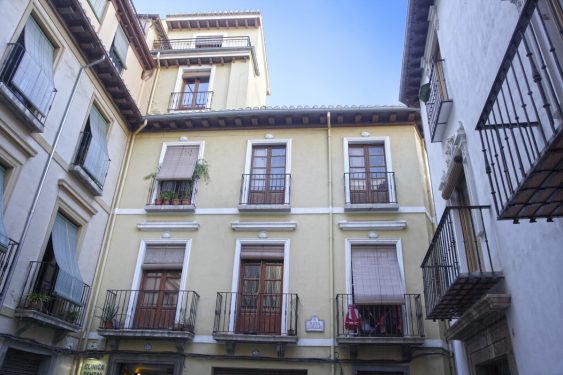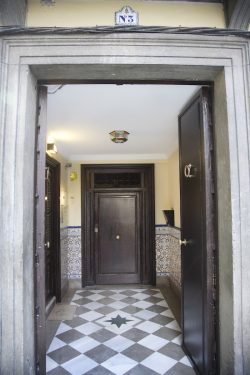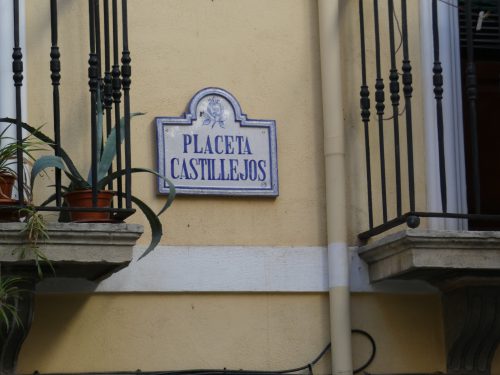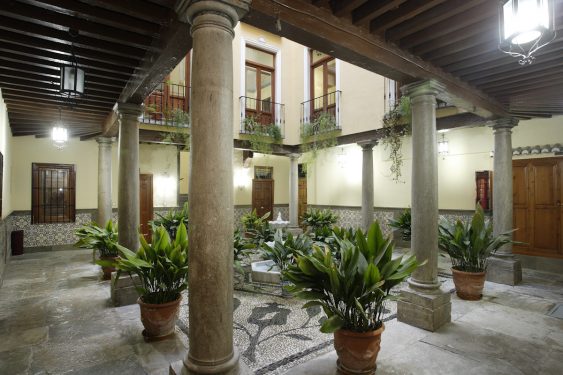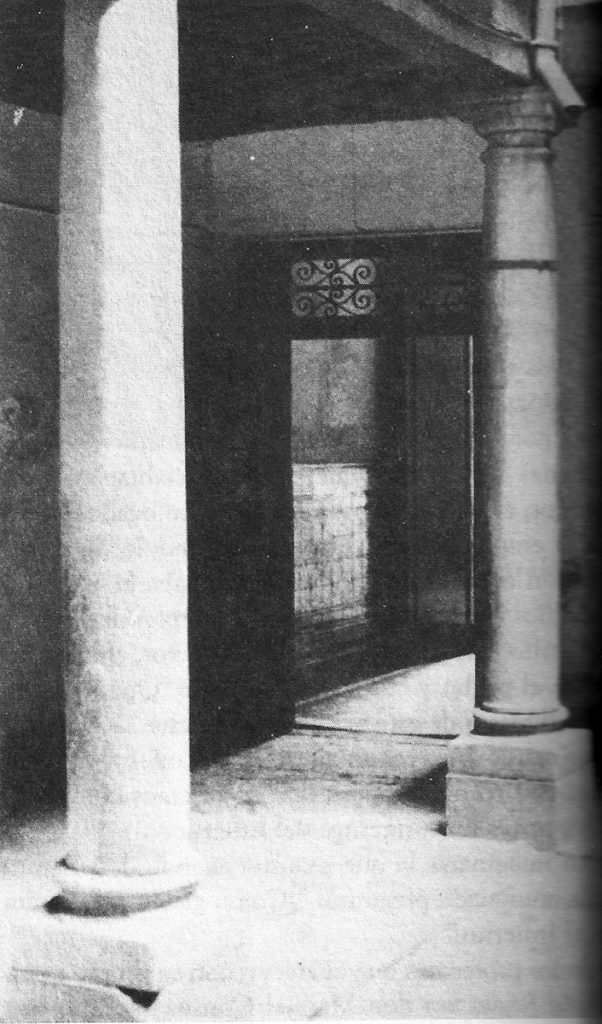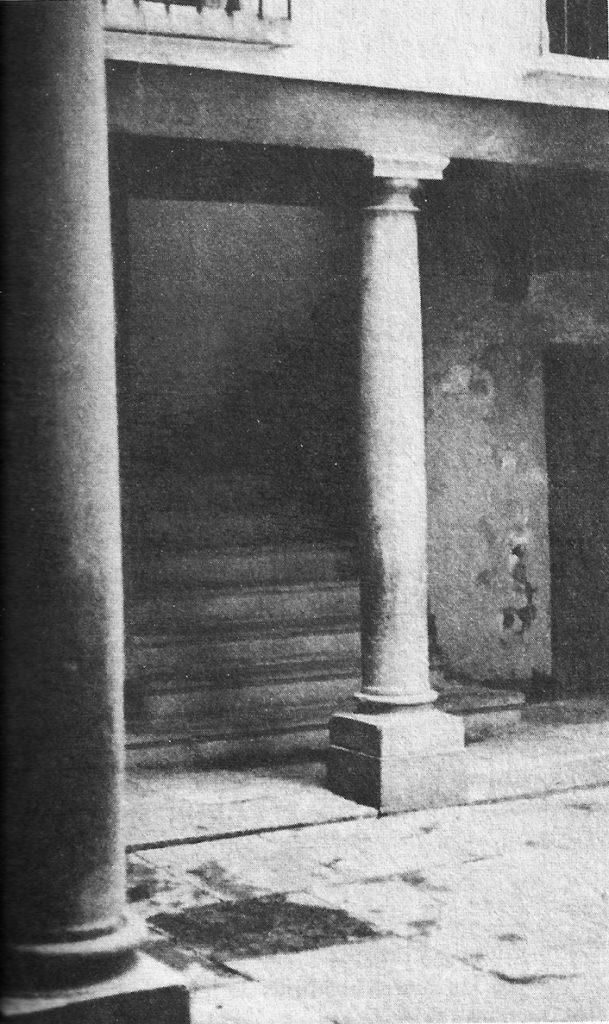A secular school where Federico and Francisco García Lorca received high school support classes. The building, privately owned, retains original elements.
Federico García Lorca’s high school studies after the family moved to Granada had two main scenarios, the General Technical Institute (then located in the palace of the Marquises of Caicedo, now the Victoria Eugenia Conservatory of Music), where he attended free and took exams, and the Sagrado Corazón School (at Plaza de Castillejos, 3) a peculiar private school, owned by Joaquín Alemán, a relative of Doña Vicenta Lorca, located in a half-hidden mansion next to San Jerónimo street which, despite its name, was in the hands of lay people.
The building, now used as apartments, retains the traces of the time, in particular its patio with columns, a marble pillar and a kind of fountain attached to the wall.
The teachers who worked in that shady building had very particular characteristics, with a deep theatrical air that would delight Federico and that will appear quoted in Doña Rosita the Spinster with names and surnames.
At Sagrado Corazón School, Federico García Lorca showed no great interest in learning, although he was deeply impressed by the disorderly and bohemian atmosphere that he and his brother Francisco, four years his junior, encountered. “How many times I must have heard that cultivated voice saying ‘Federico, study!’ The high school and college years were certainly not happy ones for Federico,” recalls his brother Francisco.
The teachers who worked in that shady building had very particular characteristics, both sad and indelible in the memory of the students who passed through there, with their deep theatrical air that would delight Federico. They were all poorly paid teachers with whom the students established special relationships. Some of them are mentioned in Lorca’s Doña Rosita the Spinster, with names and surnames. This is the case of Don Manuel Consuegra, a Latin teacher and bullfighting fan; or Canito, an intern who was the butt of school jokes. In case there was any extravagant element missing from the teaching staff, the director, an animal lover, installed a dovecote and a canary in the school tower.
But the teacher who most impressed Federico was Martín Scheroff y Aví, a descendant of the German colonists who settled in La Carolina (Jaén), in charge of Literature and Precepts, although he was a pharmacist by profession and a secret playwright. The personality of Don Martín touched him so deeply that many years later he brought him back to life. Federico attended school and the General Technical Institute until he enrolled in the School of Law, spurred on by his father.
One of the most unique teachers of that unique school was the mathematics teacher, Don Benito Campoy. According to the portrait drawn by Francisco García Lorca, he constantly poked his eyes with a handkerchief, eyes that looked like burning coals on his snowy face. Don Benito was a multiple professional, since in addition to teaching, he was also a police officer with “administrative functions”.
According to the legend that circulated in the school, in spite of the permanent irritation of his eyes, he would hypnotize minor offenders to extort confessions from them. In class he would often talk about gastronomy and praise certain exquisite dishes that in reality he only ate once a year! When he heard the director’s voice, he would cross his hands over his chest and exclaim; “What a beautiful voice the director of this reputable establishment has!”.
Another of the teachers who appears with his own name in Doña Rosita is Don Manuel Consuegra, a Latin teacher and great bullfighting fan who qualified the translations of Federico and his classmates in festive terms: “Olé, that’s a chest pass!” he would exclaim when the work satisfied him or “it was shocking” when the student shirked his duty in involuntary forgetfulness. Don Manuel was very superstitious and thus appears in Lorca’s farce: ”Llega la mala suerte! [Misfortune has arrived!]/ Por la rueda de San Bartolomé [By the wheel of St. Bartholomew] / y la varita de San José [and the wand of St. Joseph] / y la santa rama de laurel, [and the holy laurel branch,] / enemigo retírate” [enemy withdraw.”]
García Lorca thought of writing Doña Rosita, where the teachers of the Sagrado Corazón School in the San Vicente Farmhouse appear in 1934, many years after his school experience. In a letter dated “July-August 1934” addressed to Rafael Martínez Nadal he writes: “Dearest Rafael! Here I am finishing the last scene of Yerma and planning Doña Rosita the Spinster or The Language of Flowers, the first comedy of the nineteenth century. In a few days I will be in Madrid and will then go to Santander with La Barraca, where I will stay for a short while. On my return you will come with me to the San Vicente Farmhouse to spend a long season in which you can study and enjoy this silence and this prodigious scent of jasmine. So don’t make any summer plans. On my return I will prepare and finish Doña Rosita which, as I have it so well thought out, will only take me a few days”. The comedy, however, he would not finish until the spring of 1935 and far away from the Farmhouse.
MARTÍN. My life as always. I just came from explaining my Precepts class. A real hell. It was a beautiful lesson: “Concept and definition of Harmony”, but the children are not interested at all. And what children! As they see me as useless, they respect me a little bit; sometimes a pin on the seat, or a little toy figure on my back, but they do horrible things to my classmates. They are the children of the rich and, as they pay, they cannot be punished. That’s what the director always tells us. Yesterday they insisted that poor Mr. Canito, the new Geography teacher, was wearing a corset, because his body tilts backwards, and when he was alone in the yard, the big boys and the boarders got together, stripped him from the waist up, tied him to one of the columns in the corridor and threw a pitcher of water at him from the balcony.
TÍA. Poor creature!
MARTÍN. Every day I enter the school trembling in anticipation of what they are going to do to me, although, as I say, they are rather respectful of my misfortune. A while ago there was a huge scandal, because Mr. Consuegra, who is an admirable Latin teacher, had found cat excrement on his class list.
TÍA. ¡They are the enemy!
MARTÍN. They are the ones who pay and we live with them. And, believe me, the parents laugh at the infamies, because as we are the interns and we are not going to examine their children, they see us as men without feeling, as people placed in the last step of people who still wear a tie and an ironed collar.
TÍA. Oh, Don Martin, what a world this is!
MARTÍN. What a world! I always dreamed of being a poet. They gave me a natural flower and I wrote a play that could never be performed.
(Doña Rosita the Spinster or the Language of Flowers (Third Act))- Ian Gibson. In Granada, his Granada. Plaza and Janés. Barcelona, 1989.
- Francisco García Lorca. Federico and his World. Alianza, Madrid, 1990.
- Federico García Lorca. Complete Works, II. RBA-Instituto Cervantes. Madrid, 2006.
- Jesús Ortega. Album. Huerta de san Vicente, 2015.
- Jacinto S. Martín. García Lorca Bachelor. Alhulia. Granada, 1998.
- Lorca´s location
- Sagrado Corazón School
- current location
- Placeta Castillejos, 3
- ADDRESS
- Placeta Castillejos, 3
- DETAILS OF THE VISIT
The building occupied by the Sagrado Corazón School is now a block of private apartments. It can only be seen from the outside.
